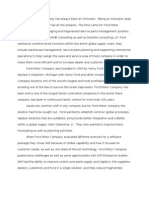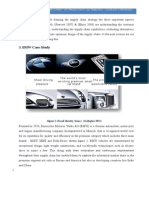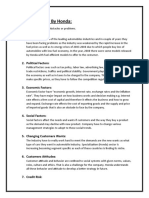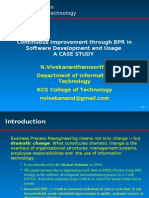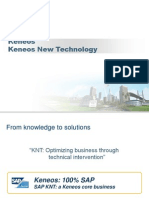0 ratings0% found this document useful (0 votes)
477 viewsWhat Are The Challenges That Enterprise Applications Pose, and How Are Enterprise Applications Taking Advantage of New Technologies?
What Are The Challenges That Enterprise Applications Pose, and How Are Enterprise Applications Taking Advantage of New Technologies?
Uploaded by
Agung WidiyantoroThis document discusses the challenges of enterprise applications and how they are evolving. It notes that while enterprise applications promise benefits like reduced costs and improved customer response, they are challenging to implement due to requiring significant technological and process changes across organizations. It also discusses how enterprise applications are addressing these issues through more flexible cloud-based options, social CRM tools, business intelligence integration, and focusing on minimizing customizations.
Copyright:
© All Rights Reserved
Available Formats
Download as DOCX, PDF, TXT or read online from Scribd
What Are The Challenges That Enterprise Applications Pose, and How Are Enterprise Applications Taking Advantage of New Technologies?
What Are The Challenges That Enterprise Applications Pose, and How Are Enterprise Applications Taking Advantage of New Technologies?
Uploaded by
Agung Widiyantoro0 ratings0% found this document useful (0 votes)
477 views5 pagesThis document discusses the challenges of enterprise applications and how they are evolving. It notes that while enterprise applications promise benefits like reduced costs and improved customer response, they are challenging to implement due to requiring significant technological and process changes across organizations. It also discusses how enterprise applications are addressing these issues through more flexible cloud-based options, social CRM tools, business intelligence integration, and focusing on minimizing customizations.
Original Description:
terjemahan
Original Title
9.5
Copyright
© © All Rights Reserved
Available Formats
DOCX, PDF, TXT or read online from Scribd
Share this document
Did you find this document useful?
Is this content inappropriate?
This document discusses the challenges of enterprise applications and how they are evolving. It notes that while enterprise applications promise benefits like reduced costs and improved customer response, they are challenging to implement due to requiring significant technological and process changes across organizations. It also discusses how enterprise applications are addressing these issues through more flexible cloud-based options, social CRM tools, business intelligence integration, and focusing on minimizing customizations.
Copyright:
© All Rights Reserved
Available Formats
Download as DOCX, PDF, TXT or read online from Scribd
Download as docx, pdf, or txt
0 ratings0% found this document useful (0 votes)
477 views5 pagesWhat Are The Challenges That Enterprise Applications Pose, and How Are Enterprise Applications Taking Advantage of New Technologies?
What Are The Challenges That Enterprise Applications Pose, and How Are Enterprise Applications Taking Advantage of New Technologies?
Uploaded by
Agung WidiyantoroThis document discusses the challenges of enterprise applications and how they are evolving. It notes that while enterprise applications promise benefits like reduced costs and improved customer response, they are challenging to implement due to requiring significant technological and process changes across organizations. It also discusses how enterprise applications are addressing these issues through more flexible cloud-based options, social CRM tools, business intelligence integration, and focusing on minimizing customizations.
Copyright:
© All Rights Reserved
Available Formats
Download as DOCX, PDF, TXT or read online from Scribd
Download as docx, pdf, or txt
You are on page 1of 5
What are the challenges that enterprise applications pose, and how are enterprise
applications taking advantage of new technologies?
Many firms have implemented enterprise systems and systems for supply chain and customer
relationship management because they are such powerful instruments for achieving operational
excellence and enhancing decision making. But precisely because they are so powerful in
changing the way the organization works, they are challenging to implement. Let’s briefly
examine some of these challenges as well as new ways of obtaining value from these systems.
Enterprise Application Challenges
Promises of dramatic reductions in inventory costs, order-to-delivery time, more efficient
customer response, and higher product and customer profitability make enterprise systems and
systems for SCM and CRM very alluring. But to obtain this value, you must clearly understand
how your business has to change to use these systems effectively.
Enterprise applications involve complex pieces of software that are very expensive to purchase
and implement. It might take a large Fortune 500 company several years to complete a large-
scale implementation of an enterprise system or a system for SCM or CRM. According to a 2018
survey of 237 ERP users conducted by Panorama Consulting Solutions, ERP projects took an
average of 17.4 months to complete, and 44 percent of the projects delivered 50 percent or less
of the expected benefits. Approximately 64 percent of these projects experienced cost overruns,
and 79 percent exceeded their initial timelines (Panorama Consulting Solutions, 2018). Changes
in project scope and additional customization work add to implementation delays and costs.
Enterprise applications require not only deep-seated technological changes but also fundamental
changes in the way the business operates. Companies must make sweeping changes to their
business processes to work with the software. Employees must accept new job functions and
responsibilities. They must learn how to perform a new set of work activities and understand
how the information they enter into the system can affect other parts of the company. This
requires new organizational learning and should also be factored into ERP implementation costs.
SCM systems require multiple organizations to share information and business processes. Each
participant in the system may have to change some of its processes and the way it uses
information to create a system that best serves the supply chain as a whole.
Some firms experienced enormous operating problems and losses when they first implemented
enterprise applications because they didn’t understand how much organizational change was
required. For example, Kmart had trouble getting products to store shelves when it first
implemented i2 Technologies (now JDA Software) SCM software. The i2 software did not work
well with Kmart’s promotion- driven business model, which created sharp spikes in demand for
products. Supermarket giant Woolworth’s Australia encountered data-related problems when it
transitioned from an antiquated home-grown ERP system to SAP. Weekly profit-and-loss reports
tailored for individual stores couldn’t be generated for nearly 18 months. The company had to
change its data collection procedures, but failed to understand its own processes or properly
document these business processes.
Enterprise applications also introduce switching costs. When you adopt an enterprise application
from a single vendor, such as SAP, Oracle, or others, it is very costly to switch vendors, and your
firm becomes dependent on the vendor to upgrade its product and maintain your installation.
Enterprise applications are based on organization-wide definitions of data. You’ll need to
understand exactly how your business uses its data and how the data would be organized in a
CRM, SCM, or ERP system. CRM systems typically require some data cleansing work.
Enterprise software vendors are addressing these problems by offering pareddown versions of
their software and fast-start programs for small and mediumsized businesses and best-practice
guidelines for larger companies. Companies are also achieving more flexibility by using cloud
applications for functions not addressed by the basic enterprise software so that they are not
constrained by a single do-it-all type of system.
Companies adopting enterprise applications can also save time and money by keeping
customizations to a minimum. For example, Kennametal, a $2 billion metal-cutting tools
company in Pennsylvania, had spent $10 million over 13 years maintaining an ERP system with
more than 6,400 customizations. The company replaced it with a plain-vanilla, uncustomized
version of SAP enterprise software and changed its business processes to conform to the
software. Office Depot avoided customization when it moved from in-house systems to the
Oracle ERP Cloud. The retailer is using best practices embedded in Oracle’s Supply Chain
Management Cloud and in its cloud-based Human Capital Management (HCM) and Enterprise
Performance Management (EPM) systems. By not customizing its Oracle ERP applications,
Office Depot simplified its information systems and reduced the cost of maintaining and
managing them (Thibodeau, 2018).
Next-Generation Enterprise Applications
Today, enterprise application vendors are delivering more value by becoming more flexible,
user-friendly, web-enabled, mobile, and capable of integration with other systems. Stand-alone
enterprise systems, customer relationship management systems, and SCM systems are becoming
a thing of the past. The major enterprise software vendors have created what they call enterprise
solutions, enterprise suites, or e-business suites to make their CRM, SCM, and ERP systems
work closely with each other and link to systems of customers and suppliers.
Next-generation enterprise applications also include cloud solutions as well as more functionality
available on mobile platforms. Large enterprise software vendors such as SAP, Oracle,
Microsoft, and Epicor now feature cloud versions of their flagship ERP systems and also cloud-
based products for small and medium-sized businesses (as described earlier in the Interactive
Session on Management). SAP, for example, offers SAP S/4HANA Cloud for large companies,
and SAP Business ByDesign and SAP Business One enterprise software for medium-sized and
small businesses. Microsoft offers the Dynamics 365 cloud version of its ERP and CRM
software. Cloud-based enterprise systems are also offered by smaller vendors such as NetSuite.
The undisputed global market leader in cloud-based CRM systems is Salesforce.com, which we
described in Chapter 5. Salesforce.com delivers its service through Internet-connected computers
or mobile devices, and it is widely used by small, medium-sized, and large enterprises. As cloud-
based products mature, more companies, including very large Fortune 500 firms, are choosing to
run all or part of their enterprise applications in the cloud.
Social CRM
CRM software vendors are enhancing their products to take advantage of social networking
technologies. These social enhancements help firms identify new ideas more rapidly, improve
team productivity, and deepen interactions with customers (see Chapter 10). Using social CRM
tools, businesses can better engage with their customers by, for example, analyzing their
sentiments about their products and services.
Social CRM tools enable a business to connect customer conversations and relationships from
social networking sites to CRM processes. The leading CRM vendors now offer such tools to
link data from social networks to their CRM software. SAP, Salesforce.com, and Oracle CRM
products now feature technology to monitor, track, and analyze social media activity on
Facebook, LinkedIn, Twitter, YouTube, and other sites. Business intelligence and analytics
software vendors such as SAS also have capabilities for social media analytics (with several
measures of customer engagement across a variety of social networks) along with campaign
management tools for testing and optimizing both social and traditional web-based campaigns.
Salesforce.com connected its system for tracking leads in the sales process with social-listening
and social-media marketing tools, enabling users to tailor their social-marketing dollars to core
customers and observe the resulting comments. If an ad agency wants to run a targeted Facebook
or Twitter ad, these capabilities make it possible to aim the ad specifically at people in the
client’s lead pipeline who are already being tracked in the CRM system. Users will be able to
view tweets as they take place in real time and perhaps uncover new leads. They can also
manage multiple campaigns and compare them all to figure out which ones generate the highest
click-through rates and cost per click.
Business Intelligence in Enterprise Applications
Enterprise application vendors have added business intelligence features to help managers obtain
more meaningful information from the massive amounts of data these systems generate,
including data from the Internet of Things (IoT). SAP now makes it possible for its enterprise
applications to use HANA in-memory computing technology so that they are capable of much
more rapid and complex data analysis. Included are tools for flexible reporting; ad hoc analysis;
interactive dashboards; what-if scenario analysis; data visualization; and machine learning to
analyze very large bodies of data, make connections, make predictions, and provide
recommendations for operations optimization. For example, SAP created a machine learning and
neural network application (see Chapter 11) that recognizes patterns associated with machine
performance in the oil and gas industry. The software automatically generates notifications of
potential machine failures and sends them to SAP Plant Maintenance, which planners use to
schedule machine repair and replacement (Franken, 2018).
The major enterprise application vendors offer portions of their products that work on mobile
handhelds. You can find out more about this topic in our Learning Track on Wireless
Applications for Customer Relationship Management, Supply Chain Management, and
Healthcare. 9-5
How will MIS help my career?
Here is how Chapter 9 and this book can help you find a job as a manufacturing management
trainee.
The Company
XYZ Global Industrial Components is a large Michigan-headquartered company with 40 global
manufacturing facilities and more than 4,000 employees worldwide, and it has an open position
for a new college graduate in its Manufacturing Management Program. The company produces
fastener, engineered, and linkage and suspension components for automotive, heavy-duty trucks,
aerospace, electric utility, telecommunications, and other industries worldwide.
Position Description
The Manufacturing Management Program is a rotational, two-year program designed to nurture
and train future managers by enabling recent college graduates to acquire critical skills and
industry experience in plant, technical, and corporate environments. Job responsibilities include:
• Working with business units and project teams on systems implementation, including
implementation of ERP and JDA manufacturing systems.
• Understanding business processes and data requirements for each business unit.
• Proficiency in supporting and conducting business requirement analysis sessions.
• Tracking and documenting changes to functional and business specifications.
• Writing user documentation, instructions, and procedures.
• Monitoring and documenting post-implementation problems and revision requests.
Job Requirements
• Bachelor’s degree in IT, MIS, engineering, or related field or equivalent, with a GPA
higher than 3.0
• Demonstrated skills in Microsoft Office Suite
• Strong written and verbal communication skills
• Proven track record of accomplishments both inside and outside the educational setting
• Experience in a leadership role in a team
Interview Questions
• Describe the projects you have worked on in a team. Did you play a leadership role? Exactly
what did you do to help your team achieve its goal? Were any of these projects IT projects?
• What do you know about ERP or JDA manufacturing systems? Have you ever worked with
them? What exactly did you do with these systems?
• Tell us what you can do with Microsoft Office software. Which tools have you used? Do you
have any Access and Excel skills? What kinds of problems have you used these tools to solve?
Did you take courses in Access or Excel?
Author Tips
1. Do some research on the company, its industry, and the kinds of challenges it faces. Look
through the company’s LinkedIn page and read their posts over the past twelve months.
Are there any key trends in the LinkedIn posts for this company?
2. Review this text’s Chapter 9 on enterprise applications, Chapter 13 on developing
systems, and Chapter 14 on IT project management and implementation.
3. View YouTube videos created by major IT consulting firms that discuss the latest trends
in manufacturing technology and enterprise systems.
4. Inquire how you would be using Microsoft Office tools for the job and what Excel and
Access skills you would be expected to demonstrate. Bring examples of the work you
have done with this software. Show that you would be eager to learn what you don’t
know about these tools to fulfill your job assignments.
5. Bring examples of your writing (including some from your Digital Portfolio described in
MyLab MIS) demonstrating your analytical skills and project experience.
You might also like
- Puma Goes OmniDocument5 pagesPuma Goes OmniJyra CabelloNo ratings yet
- Chapters 7 and 8 EditedDocument20 pagesChapters 7 and 8 Editedomar_geryesNo ratings yet
- KIMBERLY CLARK VIETNAM ERP ImplementationDocument24 pagesKIMBERLY CLARK VIETNAM ERP ImplementationLamTraMy13No ratings yet
- Walmart Sales ForecastDocument13 pagesWalmart Sales Forecastramos7770% (1)
- Demand Forecast: Apple Iphone ProductsDocument12 pagesDemand Forecast: Apple Iphone ProductsNikki GenerosoNo ratings yet
- Marketing PlanDocument7 pagesMarketing Planrihatrivedi_069100% (1)
- MKT205 Chapter 2Document33 pagesMKT205 Chapter 2Thenappan GanesenNo ratings yet
- Nielsen Business CaseDocument15 pagesNielsen Business Caseapi-513723119No ratings yet
- Answers To Case1Document3 pagesAnswers To Case1Dinesh Raghavendra100% (2)
- Alliance PartnershipDocument18 pagesAlliance PartnershipRaghuRam SamudralaNo ratings yet
- Internet Transaction Server (ITS) and ITSmobileDocument37 pagesInternet Transaction Server (ITS) and ITSmobileRohini GoudNo ratings yet
- Configuration Guide For Outsourced Transportation PDFDocument118 pagesConfiguration Guide For Outsourced Transportation PDFHemanth Kumar PanagamNo ratings yet
- 3-EY - RFP Response - State of The Art SAP ERP For Pipavav - 18 AugDocument78 pages3-EY - RFP Response - State of The Art SAP ERP For Pipavav - 18 AugvickyNo ratings yet
- SAP Company Case Study Ford-FinalDocument3 pagesSAP Company Case Study Ford-FinalcdavisgirlNo ratings yet
- Adidas SCMDocument3 pagesAdidas SCMspbhuvanNo ratings yet
- HRM-3@4 Case StudyDocument6 pagesHRM-3@4 Case Studysaddam.islmNo ratings yet
- ForecastingDocument12 pagesForecastingFabrienne Kate Eugenio LiberatoNo ratings yet
- Samsung: and Product Line Product Width and Product DepthDocument9 pagesSamsung: and Product Line Product Width and Product DepthShivani PanchalNo ratings yet
- Middle Chapters 2Document5 pagesMiddle Chapters 2jtraducoesecorrecoesNo ratings yet
- Answers of Questions For DiscussionDocument5 pagesAnswers of Questions For DiscussionuosNo ratings yet
- Vinmart and LotteMartDocument17 pagesVinmart and LotteMartNguyễn Vũ ThanhNo ratings yet
- Supply Chain Analysis of Volkswagen AmericaDocument11 pagesSupply Chain Analysis of Volkswagen AmericaŞermin ŞahinNo ratings yet
- The Supply Base and Its Complexity Implications For Transaction Costs Risks Responsiveness and InnovationDocument16 pagesThe Supply Base and Its Complexity Implications For Transaction Costs Risks Responsiveness and Innovationapi-3851548No ratings yet
- Me A1.1Document9 pagesMe A1.1Truong QuyenNo ratings yet
- MKTG - Communication Mix of XIAOMIDocument4 pagesMKTG - Communication Mix of XIAOMIJeny ThomasNo ratings yet
- Case 12 Menton BankDocument2 pagesCase 12 Menton BankJi Jason100% (1)
- Case Study Analysis of Toyota Motor: Prattayadutta T-23-A PGDM2018043 Seat No-46Document6 pagesCase Study Analysis of Toyota Motor: Prattayadutta T-23-A PGDM2018043 Seat No-46PRATTAYA DUTTANo ratings yet
- Rie NevanDocument8 pagesRie NevanDH KNo ratings yet
- Holden Case StudyDocument9 pagesHolden Case StudyMohd Shahbaz HusainNo ratings yet
- 30.INS2061. Data Mining For Business Analytics. En. Tran Thi OanhDocument5 pages30.INS2061. Data Mining For Business Analytics. En. Tran Thi OanhĐồng DươngNo ratings yet
- 538ASM 2 FrontsheetDocument40 pages538ASM 2 FrontsheetNguyen Ngoc Long (FGW HN)No ratings yet
- Chapter 6 Category Strategy Development (Part 1)Document29 pagesChapter 6 Category Strategy Development (Part 1)Naufal Hilmi Ramadhan100% (1)
- Case Study A G Nico EagleDocument2 pagesCase Study A G Nico Eagleaquey1No ratings yet
- Competitive AdvantageDocument10 pagesCompetitive Advantagesivik22100% (1)
- Airtel OutsourcingDocument20 pagesAirtel OutsourcingIssam2204No ratings yet
- (인터넷과전자상거래) GLO-BUS 소개Document31 pages(인터넷과전자상거래) GLO-BUS 소개Manju HanNo ratings yet
- Group-9 INS4003.02 NetfixDocument23 pagesGroup-9 INS4003.02 NetfixChi QuỳnhNo ratings yet
- Ifm - 5Document17 pagesIfm - 5Tường LinhNo ratings yet
- Chapter 7 Section 9 AnswersDocument7 pagesChapter 7 Section 9 Answersjohn brownNo ratings yet
- Intuit Strategic Reccomendation2Document21 pagesIntuit Strategic Reccomendation2Anonymous iAsZ4D100% (1)
- Oup 3. Diana Sanitary Napkins-1 Brand RetailDocument1 pageOup 3. Diana Sanitary Napkins-1 Brand RetailNguyễn Thị Bích LệNo ratings yet
- What Is A Perceptual MapDocument6 pagesWhat Is A Perceptual MapFaidz FuadNo ratings yet
- L5 SupplyContracts UpdatedDocument44 pagesL5 SupplyContracts Updatedkit_mak_5No ratings yet
- E-Crm and M-CRMDocument5 pagesE-Crm and M-CRMJessica Rajkumari0% (1)
- Dells Just in Time Inventory Management SystemDocument19 pagesDells Just in Time Inventory Management SystemThu HươngNo ratings yet
- PBM - L1 - Product StrategyDocument11 pagesPBM - L1 - Product Strategymini2jain2000No ratings yet
- Final Kao ReportDocument15 pagesFinal Kao Reporthanahaither0% (1)
- VI DUC HUY - IBS301m - Individual Assignment 1Document12 pagesVI DUC HUY - IBS301m - Individual Assignment 1Linh NguyễnNo ratings yet
- 1Document17 pages1Saurabh Saran100% (1)
- Experiential Marketing Used by AppleDocument12 pagesExperiential Marketing Used by AppleAditya Shukla50% (2)
- Case Study - Wal MartDocument2 pagesCase Study - Wal MartRanveer25% (4)
- Coach Inc. Case AnalysisDocument33 pagesCoach Inc. Case AnalysisLinhBí71% (7)
- Obstacles Faced by HondaDocument4 pagesObstacles Faced by HondaAyesha KhanNo ratings yet
- Samsung MarketingDocument20 pagesSamsung Marketingaryan207No ratings yet
- DellDocument38 pagesDellMishra SukeshNo ratings yet
- PTTCDN D02 Team-05 Hoa-Sen-GroupDocument61 pagesPTTCDN D02 Team-05 Hoa-Sen-GroupHợp NguyễnNo ratings yet
- Analyzing Sony and Biti's Case StudyDocument15 pagesAnalyzing Sony and Biti's Case Studytran chiNo ratings yet
- A Study of Business Process: Case Study Approach To PepsicoDocument16 pagesA Study of Business Process: Case Study Approach To Pepsicothuylinh voNo ratings yet
- Analyse The Customer Behavior of KIDO FOODsDocument1 pageAnalyse The Customer Behavior of KIDO FOODsNguyễn XuânNo ratings yet
- ITM Dominos Sales MGMT SysDocument15 pagesITM Dominos Sales MGMT SysRima Chakravarty SondeNo ratings yet
- BPR Case StudyDocument32 pagesBPR Case StudyN.Vivekananthamoorthy0% (1)
- Agenda: Company Profile. Information Systems. Information Systems at Apple Erp at Apple Implementing Erp. ProposalsDocument29 pagesAgenda: Company Profile. Information Systems. Information Systems at Apple Erp at Apple Implementing Erp. ProposalsMuhammad SubhaniNo ratings yet
- Marketing Information System A Complete Guide - 2020 EditionFrom EverandMarketing Information System A Complete Guide - 2020 EditionNo ratings yet
- Digital Transformation In Manufacturing A Complete Guide - 2020 EditionFrom EverandDigital Transformation In Manufacturing A Complete Guide - 2020 EditionNo ratings yet
- SAP HANA Modeling GuideDocument266 pagesSAP HANA Modeling GuideDamandeep Thakur100% (1)
- SmartForms - ConceptualDocument32 pagesSmartForms - ConceptualYong Benedict100% (2)
- Cc8feec45e68c3a4a5823cb6619.html: Point of View - SMP Vs SAP FioriDocument8 pagesCc8feec45e68c3a4a5823cb6619.html: Point of View - SMP Vs SAP FioriSuryanarayana TataNo ratings yet
- SAP Consulting Services RFP Questions and Answers 4.26.16Document8 pagesSAP Consulting Services RFP Questions and Answers 4.26.16Subhasis SikdarNo ratings yet
- Ebk8 7 Best Practices For Planning CPQ ProjectDocument20 pagesEbk8 7 Best Practices For Planning CPQ ProjectNarendra ReddyNo ratings yet
- TQC For Implementation: For Internal Sap and Partner Use OnlyDocument2 pagesTQC For Implementation: For Internal Sap and Partner Use OnlyCarlosNo ratings yet
- SAP Manager SD/OTC in USA Resume Sheetal KothariDocument7 pagesSAP Manager SD/OTC in USA Resume Sheetal KothariSheetalKothari0% (1)
- Piyush SharmaDocument3 pagesPiyush SharmaAbhishek Banerjee0% (1)
- 04 Intro ERP Using GBI Slides SD en v2.01Document48 pages04 Intro ERP Using GBI Slides SD en v2.01Winny IrmarookeNo ratings yet
- Sap Engineering Control CenterDocument16 pagesSap Engineering Control CenterRuben D AceroNo ratings yet
- SAP Design To Operate (D2O)Document59 pagesSAP Design To Operate (D2O)Akshay Rajan100% (1)
- Introduction To SAP SD Material MasterDocument20 pagesIntroduction To SAP SD Material MasterAJAY PALNo ratings yet
- Installation: The Intercompany Integration Solution For SAP Business One Version 2.0 For SAP Business One 9.1Document20 pagesInstallation: The Intercompany Integration Solution For SAP Business One Version 2.0 For SAP Business One 9.1Harpy AhmedNo ratings yet
- The Secrets To Reporting Success Using SAP QueryDocument132 pagesThe Secrets To Reporting Success Using SAP QueryScott HardyNo ratings yet
- Case - Marico SCMDocument26 pagesCase - Marico SCMChandan Gupta50% (2)
- 1790527 - Transaction OAMK OAMK2 Company Code is not listed (1)Document2 pages1790527 - Transaction OAMK OAMK2 Company Code is not listed (1)panxos81No ratings yet
- Reporting and Budgeting With SAP BPCDocument31 pagesReporting and Budgeting With SAP BPCnitin_tomerNo ratings yet
- Tax InterfaceDocument183 pagesTax Interfacenyskjerrig.per0% (1)
- Status CROK Is Set Instead of CTCM When Insp. Lot Is CreatedDocument2 pagesStatus CROK Is Set Instead of CTCM When Insp. Lot Is CreatedMustapure AvinashNo ratings yet
- Keneos - KNT Bu Presentation 03Document14 pagesKeneos - KNT Bu Presentation 03AntonioLeitesNo ratings yet
- Urban Administration and Development Department Rewa Madhya Pradesh - 2032018113548416 PDFDocument45 pagesUrban Administration and Development Department Rewa Madhya Pradesh - 2032018113548416 PDFAkshat MishraNo ratings yet
- 48 SAP Projects and Ticket HandlingDocument16 pages48 SAP Projects and Ticket HandlingSrini Vasan100% (1)
- SAP Engineering Control Center Interface To AutoCAD - ENDocument2 pagesSAP Engineering Control Center Interface To AutoCAD - ENrhageztNo ratings yet
- 7 - Open SAP - General PDFDocument64 pages7 - Open SAP - General PDFManuel Alejandro Quinchoa QuinchoaNo ratings yet
- Sap Bydesign Fact SheetDocument29 pagesSap Bydesign Fact SheetAnn Nguyen100% (2)













